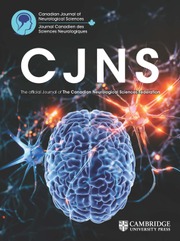No CrossRef data available.
Article contents
Corpora Amylacea Mimicking Diffuse Glioma: A Rare Case of Extensive Periventricular Accumulation
Published online by Cambridge University Press: 07 July 2025
Abstract
An abstract is not available for this content so a preview has been provided. Please use the Get access link above for information on how to access this content.
Keywords
Information
- Type
- Neuroimaging Highlight
- Information
- Copyright
- © The Author(s), 2025. Published by Cambridge University Press on behalf of Canadian Neurological Sciences Federation
References
Rauch, M, Lachner, K, Frickel, L, et al. Focally enlarged perivascular spaces in pediatric and adolescent patients with polymicrogyria-an MRI study. Clin Neuroradiol. 2025;35(1):87–93.CrossRefGoogle ScholarPubMed
Chung, MH, Horoupian, DS. Corpora amylacea: a marker for mesial temporal sclerosis. J Neuropathol Exp Neurol. 1996;55(4):403–8.10.1097/00005072-199604000-00002CrossRefGoogle ScholarPubMed
Nishio, S, Morioka, T, Kawamura, T, Fukui, K, Nonaka, H, Matsushima, M. Corpora amylacea replace the hippocampal pyramidal cell layer in a patient with temporal lobe epilepsy. Epilepsia. 2001;42(7):960–2.10.1046/j.1528-1157.2001.01601.xCrossRefGoogle Scholar
Selmaj, K, Pawłowska, Z, Walczak, A, Koziołkiewicz, W, Raine, CS, Cierniewski, CS. Corpora amylacea from multiple sclerosis brain tissue consists of aggregated neuronal cells. Acta Biochim Pol. 2008;55(1):43–9.10.18388/abp.2008_3199CrossRefGoogle ScholarPubMed
van de Pol, LA, Hensel, A, van der Flier, WM, et al. Hippocampal atrophy on MRI in frontotemporal lobar degeneration and alzheimer’s disease. J Neurol Neurosurg Psychiatry. 2006;77(4):439–42.10.1136/jnnp.2005.075341CrossRefGoogle ScholarPubMed
Xu, C, Owen, JE, Gislason, T, Benediktsdottir, B, Robinson, SR. Quantitative analysis of size and regional distribution of corpora amylacea in the hippocampal formation of obstructive sleep apnoea patients. Sci Rep. 2021;11(1):20892.10.1038/s41598-021-99795-8CrossRefGoogle ScholarPubMed
Riba, M, Del Valle, J, Molina-Porcel, L, Pelegrí, C, Vilaplana, J. Wasteosomes (corpora amylacea) as a hallmark of chronic glymphatic insufficiency. Proc Natl Acad Sci U S A. 2022;119(48):e2211326119.10.1073/pnas.2211326119CrossRefGoogle ScholarPubMed
Leventer, RJ, Jansen, A, Pilz, DT, et al. Clinical and imaging heterogeneity of polymicrogyria: a study of 328 patients. Brain. 2010;133(Pt 5):1415–27.10.1093/brain/awq078CrossRefGoogle ScholarPubMed
Sarnat, HB, Flores-Sarnat, L. Excitatory/Inhibitory synaptic ratios in polymicrogyria and down syndrome help explain epileptogenesis in malformations. Pediatr Neurol. 2021;116:41–54.10.1016/j.pediatrneurol.2020.11.001CrossRefGoogle ScholarPubMed
Abel, TJ, Hebb, AO, Keene, CD, Born, DE, Silbergeld, DL. Parahippocampal corpora amylacea: case report. Neurosurgery. 2010;66(6):E1206–7.10.1227/01.NEU.0000369196.94664.4ECrossRefGoogle ScholarPubMed
Pimentel, J, Roque, R, Cunha, ESM. Focal cerebral accumulation of corpora amylacea. Clin Neuropathol. 2020;39(1):46–7.CrossRefGoogle ScholarPubMed
Lee, SJ, Kim, M, Lagman, C, Bui, TT, Yong, WH, Yang, I. Corpora amylacea mimicking low-grade glioma and manifesting as a seizure: case report. Surg Neurol Int. 2017;8:64.Google ScholarPubMed
Matsuo, T, Fujimoto, S, Komori, T, Nakata, Y. Case report: the origin of transmantle-like features. Front Radiol. 2022;2:927764.10.3389/fradi.2022.927764CrossRefGoogle ScholarPubMed

